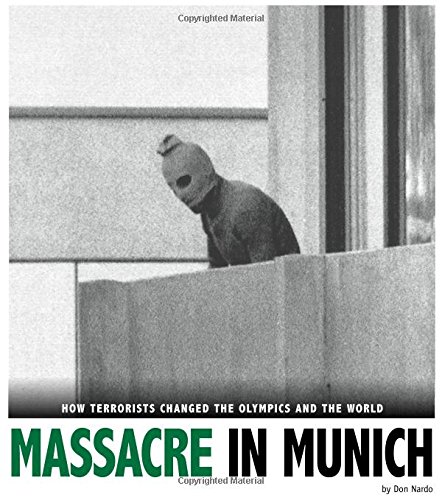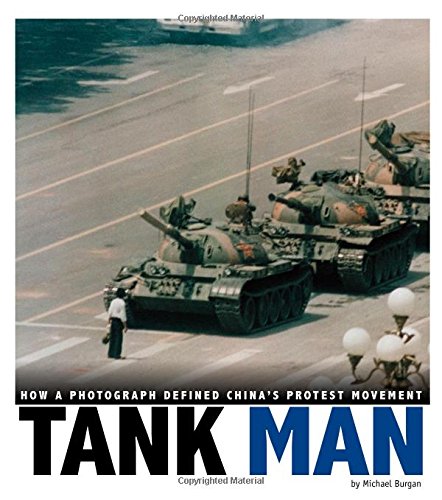-
Miracle on Ice: How a Stunning Upset United a Country
Michael Burgan
Library Binding (Compass Point Books, Jan. 1, 2016)The mighty Soviets were the favorites to win hockey gold at the 1980 Winter Olympics. But a team of U.S. college players had other ideas. The stunning upset of the Soviet hockey team by the young Americans has been called the greatest moment in international hockey. And to many people the victory was about much more than sports. Americans had gone through difficult times at home and abroad. Beating the best hockey team in the world―and its major Cold War rival―gave Americans a sense of pride. One iconic photo captured the impact of that “miraculous” historic event. Y
Y
-
Massacre in Munich: How Terrorists Changed the Olympics and the World
Don Nardo
Paperback (Compass Point Books, Feb. 1, 2016)An attack at the 1972 Munich Olympic Games would produce one of the defining images of international terrorism. The chilling photo of a hooded man peering from a balcony in the Olympic Village would be viewed worldwide as a horrific symbol of global terrorism. The man wearing a mask with cutout slits for his eyes was a member of the Palestinian terrorist group Black September. He and his fellow terrorists had seized 11 members of the Israeli Olympic delegation and were holding them hostage. They would kill them all as the tragedy unfolded. What had been dubbed the “happy Olympics” would be forever remembered as the Munich massacre. The Olympics would never the same. Y
Y
-
What a Kick: How a Clutch World Cup Win Propelled Women's Soccer
Emma Carlson-Berne
Paperback (Compass Point Books, Feb. 1, 2016)It was the biggest event in the history of women's sports. And for the Americans, it came down to five kicks. After regulation play and two overtimes in the final game of the 1999 women's World Cup soccer match, the score was 0-0. Penalty kicks would decide the world champion. The Chinese and the Americans would each pick five players. One kick per player. With the score tied 4-4, the Americans had one more chance to win it all. Brandi Chastain was up. If she made her kick, the Americans would win the World Cup. Success! After her winning goal, Chastain dropped to the turf, whipped off her jersey, and screamed with joy. The photo of the triumphant female athlete would circle the globe. Twenty-seven years after Title IX, the world now knew that women's sports had arrived. The victory was more than the end of a soccer game. It was the end of a crusade to prove that women's sports should be taken as seriously as men's. What a win! X
X
-
Exposing Hidden Worlds: How Jacob Riis' Photos Became Tools for Social Reform
Michael Burgan
Library Binding (Compass Point Books, Aug. 1, 2017)President Theodore Roosevelt called Jacob Riis "the best American I ever knew." The pioneering photojournalist, an immigrant from Denmark, drew attention to the poverty and evils of slum life in the late 1800s. Riis won national acclaim when his photos illustrated his bestselling book How the Other Half Lives. The book focused on the difficult time immigrants faced as thousands of newcomers flooded into the United States each year. Riis called for reform and hoped to prod government officials to help the poor people who were forced to live under horrible conditions. The impact of Riis' photos came from capturing the poor and homeless as they lived and worked, with the subjects' eyes often staring directly into the camera. The great photographer Ansel Adams called them "magnificent achievements in the field of humanistic photography." But the reforms that came from Riis' work have not eliminated urban poverty and homelessness, and important work remains to be done. Z
Z
-
Migrant Mother: How a Photograph Defined the Great Depression
Don Nardo, Kathleen Baxter, Alexa L. Sandmann Ed.D.
Paperback (Compass Point Books, Feb. 1, 2011)In the 1930s, photographer Dorothea Lange traveled the American West documenting the experiences of those devastated by the Great Depression. She wanted to use the power of the image to effect political change, but even she could hardly have expected the effect that a simple portrait of a worn-looking woman and her children would have on history. This image, taken at a migrant workers' camp in Nipomo, California, would eventually come to be seen as the very symbol of the Depression. The photograph helped reveal the true cost of the disaster on human lives and shocked the U.S. government into providing relief for the millions of other families devastated by the Depression. Y
Y
-
Black Power Salute: How a Photograph Captured a Political Protest
Danielle Smith-Llera
Library Binding (Compass Point Books, Jan. 1, 2017)Two American athletes made history at the 1968 Summer Olympics, but not on the track. They staged a silent protest against racial injustice. Tommie Smith and John Carlos, gold and bronze medalists in the 200-meter sprint, stood with heads bowed and black-gloved fists raised as the national anthem played during the medal ceremony. The Australian silver medalist wore a human rights badge in support. All three would pay a heavy price for their activism. A Life magazine photograph seen by millions would ensure that the silent protest was remembered, and eventually admired, as a symbol of the battle for equality and civil rights. Z
Z
-
Little Rock Girl 1957: How a Photograph Changed the Fight for Integration
Shelley Marie Tougas
Library Binding (Compass Point Books, July 1, 2011)Nine African American students made history when they defied a governor and integrated an Arkansas high school in 1957. It was the photo of a young girl trying to enter the school being taunted, harassed and threatened by an angry mob that grabbed the world's attention and kept its disapproving gaze on Little Rock, Arkansas. In defiance of a federal court order, Governor Orval Faubus called in the National Guard to prevent the students from entering all white Central High School. The plan had been for the students to meet and go to school as a group on September 4, 1957. But one student didn't hear of the plan and tried to enter the school alone. A chilling photo by newspaper photographer Will Counts captured the sneering expression of a girl in the mob and made history. Years later Counts snapped another photo, this one of the same two girls, now grownup, reconciling in front of Central High School. X
X
-
Tank Man: How a Photograph Defined China's Protest Movement
Michael Burgan
Paperback (Compass Point Books, March 1, 2014)No one knew his name. But soon millions would know about his bravery. For almost two months in spring 1989, Beijing’s Tiananmen Square had been the site of growing protests against China's hardline communist government. In early June, China’s leaders had had enough. In a matter of days soldiers cleared the square. They used sticks and cattle prods. They shot rubber bullets, then real ones. They used bayonets. Student protesters fought back with firebombs and rocks, but they were no match for the soldiers. Gunfire still rang out in parts of Beijing, but China’s leaders felt in control. As tanks rumbled through the streets near Tiananmen Square, a man in a white shirt came suddenly into view. He held up his right hand, like a police officer trying to halt traffic. The first huge tank in a row of four stopped just a few feet in front of the man. The tanks behind it stopped as well. Photographer Jeff Widener took a picture of the brave protester halting the huge armored fighting vehicles. The image was soon sent around the world, becoming one of the most famous photographs ever. Z
Z
-
Olympic Gold 1936: How the Image of Jesse Owens Crushed Hitler's Evil Myth
Michael Burgan
Library Binding (Compass Point Books, Jan. 1, 2017)Jesse Owens’ gold-medal winning feats at the 1936 Olympics in Berlin struck a mighty propaganda blow against Adolf Hitler. The Nazi leader had planned to use the German games as a showcase of supposed Aryan superiority. Instead there was American black athlete Owens on the podium being photographed by Hitler’s personal photographer, Heinrich Hoffmann. In addition, Owens would figure prominently in the groundbreaking film Olympia by Hitler’s favorite director Leni Riefenstahl. Photo and film captured Owens’ stunning success and revealed how wrong Hitler was in his beliefs. Z
Z
-
Serena vs. Venus: How a Photograph Spotlighted the Fight for Equality
Danielle Smith-Llera
Library Binding (Compass Point Books, Jan. 1, 2017)The final match of the 2001 U.S. Open featuring tennis stars Venus and Serena Williams was groundbreaking. It was first time siblings had squared off in the final match for more than 100 years. And it was the first time both players were black. The photo of the smiling Williams sisters holding their trophies after the tennis match appeared in newspapers around the globe. It captured two athletes who fought, and would continue to fight, for a place for women and African-Americans in tennis and the world beyond. Y
Y
-
Birmingham 1963: How a Photograph Rallied Civil Rights Support
Shelley Marie Tougas, Kathleen Baxter, Alexa L. Sandmann Ed.D.
Paperback (Compass Point Books, Feb. 1, 2010)In May 1963 news photographer Charles Moore was on hand to document the Children’s Crusade, a civil rights protest. But the photographs he took that day did more than document an event; they helped change history. His photograph of a trio of African-American teenagers being slammed against a building by a blast of water from a fire hose was especially powerful. The image of this brutal treatment turned Americans into witnesses at a time when hate and prejudice were on trial. It helped rally the civil rights movement and energized the public, making civil rights a national problem needing a national solution. And it paved the way for Congress to finally pass laws to give citizens equal rights regardless of the color of their skin. Y
Y
-
What a Kick: How a Clutch World Cup Win Propelled Women's Soccer
Emma Carlson-Berne
Library Binding (Compass Point Books, Jan. 1, 2016)It was the biggest event in the history of women's sports. And for the Americans, it came down to five kicks. After regulation play and two overtimes in the final game of the 1999 women's World Cup soccer match, the score was 0-0. Penalty kicks would decide the world champion. The Chinese and the Americans would each pick five players. One kick per player. With the score tied 4-4, the Americans had one more chance to win it all. Brandi Chastain was up. If she made her kick, the Americans would win the World Cup. Success! After her winning goal, Chastain dropped to the turf, whipped off her jersey, and screamed with joy. The photo of the triumphant female athlete would circle the globe. Twenty-seven years after Title IX, the world now knew that women's sports had arrived. The victory was more than the end of a soccer game. It was the end of a crusade to prove that women's sports should be taken as seriously as men's. What a win! X
X